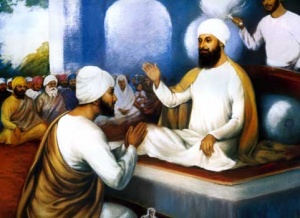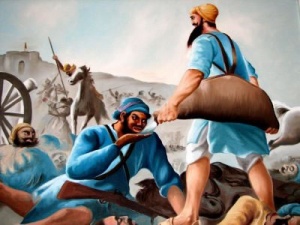Sewapanthi: Difference between revisions
No edit summary |
No edit summary |
||
| Line 1: | Line 1: | ||
[[Image:Bhaikanhaiya.jpg|thumb|right|300px|Bhai Kanahiya & Guru Tegh Bahadur]] | |||
'''Sewapanthi or Sevapanthi or Addanshahi''' is a great traditional Sikh orders, a sect was started by Bhai Kanhaiya, after searching for a spiritual guide amongst Hindus and Muslims, he became a [[Sikh]] of the [[Guru Tegh Bahadur|Ninth Sikh Guru]]. Guru Tegh Bahadur instructed Khanaiya to go out and serve humanity. Thus began the life time work of Bhai Khanaiya, ‘Seva’, self-abnegating service to all living things. | |||
==History== | |||
He was born in 1648 in a town called Sohadara now in [[Pakistan]]. In time, [[Guru Tegh Bahadur]] had a personal follower, one Kanhaya Lal a Dhamman (Dhiman) Khatri of Sodhra in Gujranwala. Originally an officer in the service of the Mughals, he became a drawer of water to.the Guru's horses and to all with him and a menial at his table day and night. The Guru taught him and invested him with the seli and topi. On Guru' Tegh Bahadur's death Kanhaya Lal remained in Govind Singh's service and was with him at the siege of Anandpur. One day he heard some one say: "0 heart, love God," and accordingly in the battle that ensued he gave water to the wounded on either side, justifying his act by a Sikh text. From his personal service (sewa) or more probably from Sewa Ram, his first disciple, his followers are called Sewa-panthis: but in Amritsar they are known as Adan-Shahis, from Adan Shah, another disciple of Kanhaya' Lal, and ' a rich banker who devoted his wealth and leisure to the propagation of their doctrines'. Their charity to travellers and persons in distress is proverbial. Kanhaya' Lal is said to have been commissioned by [[Guru Gobind Singh]] to preach Sikhism in the south-west and he founded his first dharamsala in the Thal or steppe of the Sind Sagar Doab. His followers are mainly Khatris and Aroras of that tract and the disciples are styled Nanak-Shahis, make ropes for a livelihood, refus-ing all alms and oblations. Some Sewapanthis are said to shave, others not. They are celibate and eat and share property together. Flesh, liquor and hemp are avoided. Their dress is white. Macauliffe describes them as an orthodox and honourable sect who live by honest labour.Sewapanthi is also spelled as [[Sevapanthi]]. | |||
[[Image:Bhaikanhaiyag.jpg|thumb|right|300px|bhai Kanahiya Giving water to mughals]] | |||
==Refrences== | ==Refrences== | ||
www.sewapanthi.org | www.sewapanthi.org | ||
Revision as of 14:12, 16 August 2008
Sewapanthi or Sevapanthi or Addanshahi is a great traditional Sikh orders, a sect was started by Bhai Kanhaiya, after searching for a spiritual guide amongst Hindus and Muslims, he became a Sikh of the Ninth Sikh Guru. Guru Tegh Bahadur instructed Khanaiya to go out and serve humanity. Thus began the life time work of Bhai Khanaiya, ‘Seva’, self-abnegating service to all living things.
History
He was born in 1648 in a town called Sohadara now in Pakistan. In time, Guru Tegh Bahadur had a personal follower, one Kanhaya Lal a Dhamman (Dhiman) Khatri of Sodhra in Gujranwala. Originally an officer in the service of the Mughals, he became a drawer of water to.the Guru's horses and to all with him and a menial at his table day and night. The Guru taught him and invested him with the seli and topi. On Guru' Tegh Bahadur's death Kanhaya Lal remained in Govind Singh's service and was with him at the siege of Anandpur. One day he heard some one say: "0 heart, love God," and accordingly in the battle that ensued he gave water to the wounded on either side, justifying his act by a Sikh text. From his personal service (sewa) or more probably from Sewa Ram, his first disciple, his followers are called Sewa-panthis: but in Amritsar they are known as Adan-Shahis, from Adan Shah, another disciple of Kanhaya' Lal, and ' a rich banker who devoted his wealth and leisure to the propagation of their doctrines'. Their charity to travellers and persons in distress is proverbial. Kanhaya' Lal is said to have been commissioned by Guru Gobind Singh to preach Sikhism in the south-west and he founded his first dharamsala in the Thal or steppe of the Sind Sagar Doab. His followers are mainly Khatris and Aroras of that tract and the disciples are styled Nanak-Shahis, make ropes for a livelihood, refus-ing all alms and oblations. Some Sewapanthis are said to shave, others not. They are celibate and eat and share property together. Flesh, liquor and hemp are avoided. Their dress is white. Macauliffe describes them as an orthodox and honourable sect who live by honest labour.Sewapanthi is also spelled as Sevapanthi.
Refrences
www.sewapanthi.org
| Sects & Cults |
|
♣♣ Ad Dharm ♣♣ Akalis ♣♣ Bandai Sikhs ♣♣ Balmiki ♣♣ Bhatra ♣♣ Brindaban Matt ♣♣ Daya Singh Samparda ♣♣ Dhir Malias ♣♣ Handalis ♣♣ Kabir Panthi ♣♣ Kirtan jatha Group ♣♣ Kooka ♣♣ Kutta Marg ♣♣ Majhabi ♣♣ Manjis ♣♣ Masand ♣♣ Merhbanieh ♣♣ Mihan Sahibs ♣♣ Minas ♣♣ Nirankari ♣♣ Nanak panthi ♣♣ Nanakpanthi Sindhis ♣♣ Namdev Panthi ♣♣ Namdhari ♣♣ Nanaksaria ♣♣ Nihang ♣♣ Nikalsaini ♣♣ Niranjaniye ♣♣ Nirmala ♣♣ Panch Khalsa Diwan ♣♣ Parsadi Sikhs ♣♣ Phul Sahib dhuan ♣♣ Radha Swami ♣♣ Ram Raiyas ♣♣ Ravidasi ♣♣ Ridváni Sikhs ♣♣ Suthra Shahi ♣♣ Sewapanthi ♣♣ Sat kartaria ♣♣ Sant Nirankaris ♣♣ Sanwal Shahis ♣♣ Sanatan Singh Sabhais ♣♣ Sachkhand Nanak Dhaam ♣♣ Samparda Bhindra ♣♣ Tat Khalsa ♣♣ Sikligars ♣♣ Pachhada Jats ♣♣ Satnami's ♣♣ Udasi Sikhs ♣♣ |


